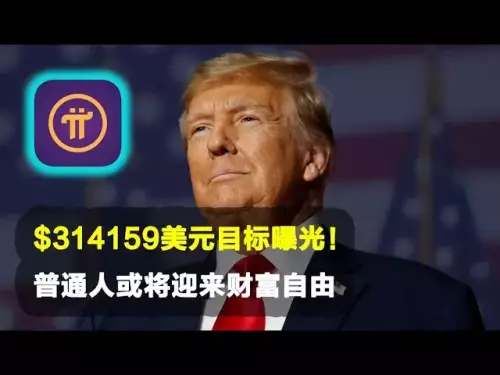 |
|
 |
|
 |
|
 |
|
 |
|
 |
|
 |
|
 |
|
 |
|
 |
|
 |
|
 |
|
 |
|
 |
|
 |
|
2025年、暗号通貨セクターは、セキュリティの懸念と技術革新が交差する重要な時期に位置しています

The State of Crypto Security: A Pivotal Year for Orthogonal Tokenization in 2025
暗号セキュリティの状態:2025年の直交トークン化のための極めて重要な年
Introduces a pivotal year for cryptocurrency security, highlighting the critical role of orthogonal tokenization algorithms in hardening digital asset ecosystems against evolving threats and technological challenges.
暗号通貨のセキュリティのために極めて重要な年を紹介し、進化する脅威と技術的課題に対するデジタル資産エコシステムを硬化させる際の直交トークン化アルゴリズムの重要な役割を強調します。
Pivotal Year for Crypto Security: Orthogonal Tokenization Takes Center Stage in 2025
暗号セキュリティのための極めて重要な年:2025年に直交トークン化が中心になります
2025 marks a watershed year for cryptocurrency security, with several key trends converging to drive rapid adoption of orthogonal tokenization algorithms. As the sector braces for new technological and regulatory challenges, the integration of these algorithms is expected to underpin the next era of trust and resilience in digital asset ecosystems.
2025年は、暗号通貨のセキュリティの分岐点を示しており、いくつかの重要な傾向が直交トークン化アルゴリズムの迅速な採用を促進するために収束します。セクターは新しい技術的および規制上の課題に包括的であるため、これらのアルゴリズムの統合は、デジタル資産エコシステムにおける次の信頼と回復力の時代を支えることが期待されています。
At the forefront of this integration are leading blockchain infrastructure providers. International Business Machines Corporation (IBM) is known for its contributions to open-source blockchain frameworks like Hyperledger, which are used by financial institutions and enterprises to build private blockchains or permissioned ledgers. In 2025, IBM announced enhancements to its Hyperledger offerings, incorporating orthogonal cryptographic primitives to ensure forward compatibility with post-quantum security standards.
この統合の最前線には、主要なブロックチェーンインフラストラクチャプロバイダーがあります。 International Business Machines Corporation(IBM)は、Hyperledgerなどのオープンソースのブロックチェーンフレームワークへの貢献で知られています。これは、金融機関や企業が民間のブロックチェーンまたは許可された元帳を構築するために使用しています。 2025年、IBMはハイパーレッドガーの提供の強化を発表しました。これは、四半期のセキュリティ基準との前向きな互換性を確保するために、直交暗号化プリミティブを組み込みました。
Meanwhile, Consensys, a major developer of Ethereum-based decentralized applications (dApps) and smart contract architectures, is collaborating with decentralized finance (DeFi) platforms to pilot orthogonal tokenization in DeFi protocols. The aim of this initiative is to reduce vulnerabilities in asset custody and transaction validation processes, which are becoming increasingly critical as DeFi protocols grow in complexity and interoperability.
一方、Ethereumベースの分散型アプリケーション(DAPPS)およびスマートコントラクトアーキテクチャの主要な開発者であるConsensysは、Defiプロトコルの直交トークン化をパイロットするために、分散型ファイナンス(DEFI)プラットフォームと協力しています。このイニシアチブの目的は、defiプロトコルが複雑さと相互運用性が成長するにつれてますます重要になっている資産の監護および取引検証プロセスの脆弱性を減らすことです。
Exchanges and custodians are also prioritizing these innovations in their technology roadmaps. Coinbase, a leading cryptocurrency exchange, has publicly committed to evaluating orthogonal tokenization as part of its ongoing security upgrades. This follows recent exploits that have targeted hot and cold storage solutions used by exchanges and institutional custodians.
交換とカストディアンは、テクノロジーのロードマップでこれらの革新を優先しています。主要な暗号通貨取引所であるCoinbaseは、進行中のセキュリティアップグレードの一環として、直交トークン化の評価に公にコミットしています。これは、取引所や制度的カストディアンが使用するホットおよびコールドストレージソリューションをターゲットにした最近のエクスプロイトに続きます。
Hardware wallet manufacturers are also exploring the use of orthogonal algorithms to reinforce device authentication and transaction signing. In response to the uptick in supply chain attacks and malware targeting offline storage, hardware wallet vendors such as Trezor are integrating orthogonal tokenization to provide an additional layer of protection for user devices and private keys.
ハードウェアウォレットメーカーは、デバイスの認証とトランザクションの署名を強化するために、直交アルゴリズムの使用も調査しています。サプライチェーン攻撃とマルウェアのオフラインストレージをターゲットにしたマルウェアの増加に応じて、Trezorなどのハードウェアウォレットベンダーは直交トークン化を統合して、ユーザーデバイスとプライベートキーの追加の保護層を提供しています。
The trajectory for orthogonal tokenization algorithms is poised for rapid acceleration in the coming years. With the looming threat of quantum decryption and increasingly complex attack surfaces, industry stakeholders anticipate that regulatory bodies may soon mandate the adoption of more advanced tokenization standards. Organizations like the International Organization for Standardization (ISO) are already conducting reviews of multi-dimensional cryptographic frameworks for potential inclusion in future compliance guidelines.
直交トークン化アルゴリズムの軌跡は、今後数年間で急速な加速を採用しています。量子復号化の迫り来る脅威とますます複雑な攻撃表面により、業界の利害関係者は、規制機関がすぐにより高度なトークン化基準の採用を義務付けていると予想しています。国際標準化機関(ISO)のような組織は、将来のコンプライアンスガイドラインに潜在的に含めるための多次元暗号化フレームワークのレビューをすでに実施しています。
Overall, 2025 marks a pivotal year for orthogonal tokenization as it transitions from a theoretical construct to an operational necessity in the cryptocurrency sector.
全体として、2025年は、理論的構成から暗号通貨セクターの運用上の必要性に移行するため、直交トークン化にとって極めて重要な年を迎えます。
What Are Orthogonal Tokenization Algorithms? Definitions and Core Principles
直交トークン化アルゴリズムとは何ですか?定義とコア原則
Orthogonal tokenization algorithms represent an emerging class of cryptographic techniques designed to enhance the security and flexibility of digital asset management within cryptocurrency ecosystems. These algorithms aim to establish independent, non-overlapping (or “orthogonal”) tokenization processes that can coexist within the same blockchain or distributed ledger, minimizing cross-token interference and reducing the risk of correlated vulnerabilities.
直交トークン化アルゴリズムは、暗号通貨エコシステム内のデジタル資産管理のセキュリティと柔軟性を高めるために設計された暗号化技術の新たなクラスを表しています。これらのアルゴリズムは、同じブロックチェーンまたは分布元帳内で共存できる独立した非重複(または「直交」)トークン化プロセスを確立し、クロストークン干渉を最小限に抑え、相関脆弱性のリスクを減らすことを目的としています。
Traditionally, tokenization in cryptocurrency involves converting sensitive data or digital assets into unique, secure tokens, which can be transacted or stored without exposing underlying information. Orthogonality, in this context, refers to the mathematical property whereby multiple tokenization streams are constructed in such a way that operations or breaches in one stream do not compromise the integrity or confidentiality of others. This is achieved through the application of independent cryptographic primitives, disjoint keyspaces, and isolated operational environments.
従来、暗号通貨でのトークン化には、機密データまたはデジタル資産を一意の安全なトークンに変換することが含まれます。これは、基礎となる情報を公開せずに取引または保存できます。この文脈では、直交性は、複数のトークン化ストリームが、あるストリームの操作または違反が他のストリームの整合性または機密性を損なわないように構築される数学的特性を指します。これは、独立した暗号化プリミティブ、分離キースペース、および孤立した運用環境を適用することで達成されます。
One central principle of orthogonal tokenization is the use of modular, composable protocols that allow different token types—such as fungible tokens, non-fungible tokens (NFTs), and utility tokens—to be created, managed, and retired without mutual interference. This modularity is increasingly relevant as blockchains such as Ethereum Foundation and Polygon Technology support a growing diversity of decentralized applications (dApps) and token standards (e.g., ERC-20, ERC-721).
直交トークン化の中心的な原則の1つは、さまざまなトークンなど、さまざまなトークン、不適切なトークン(NFT)、およびユーティリティトークンなど、異なるトークンタイプを可能にするモジュール式の構成可能なプロトコルの使用です。このモジュール性は、Ethereum FoundationやPolygon Technologyなどのブロックチェーンが、分散型アプリケーション(DAPPS)とトークン標準の多様性(ERC-20、ERC-721など)をサポートするため、ますます関連性があります。
Another key component is the implementation of domain separation within cryptographic functions. For example, smart contract platforms are now exploring domain-separated hashing and signing, ensuring that operations on one token type cannot be replayed or misused in another context. This approach is being piloted by organizations such as Hyperledger Foundation, which is investigating orthogonal tokenization for enterprise blockchain deployments.
もう1つの重要なコンポーネントは、暗号化関数内のドメイン分離の実装です。たとえば、スマートコントラクトプラットフォームは、ドメイン分離されたハッシュと署名を調査し、あるトークンタイプの操作を別のコンテキストで再生したり誤用したりできないようにしています。このアプローチは、エンタープライズブロックチェーンの展開のための直交トークン化を調査しているHyperledger Foundationなどの組織によって操縦されています。
From a security perspective, orthogonal tokenization algorithms provide strong compartmentalization, reducing the attack surface presented by multi-asset platforms. In the event of a breach or exploit affecting one token family, assets and data secured under orthogonal schemes remain protected. This is particularly significant as regulatory bodies and standards organizations, such as ISO/TC 307 (Blockchain and Distributed Ledger Technologies), emphasize the need for robust token lifecycle management and interoperability.
セキュリティの観点から、直交トークン化アルゴリズムは強力なコンパートメント化を提供し、マルチアセットプラットフォームによって提示される攻撃面を減らします。 1つのトークンファミリーに影響を与える違反またはエクスプロイトが発生した場合、直交スキームの下で保護されている資産とデータは保護されたままです。これは、ISO/TC 307(ブロックチェーンおよび分散型台帳技術)などの規制機関や標準組織が、堅牢なトークンライフサイクル管理と相互運用性の必要性を強調しているため、特に重要です。
In summary, orthogonal tokenization algorithms embody a set of definitions and principles centered on independence, modularity, and strong isolation of tokenized assets—a direction likely to underpin the next generation of cryptocurrency security architectures through 2025 and beyond.
要約すると、直交トークン化アルゴリズムは、トークン化された資産の独立性、モジュール性、強力な分離を中心とした一連の定義と原則を具体化します。
Key Industry Players and Their Innovations (e
主要業界のプレーヤーとその革新(e
免責事項:info@kdj.com
提供される情報は取引に関するアドバイスではありません。 kdj.com は、この記事で提供される情報に基づいて行われた投資に対して一切の責任を負いません。暗号通貨は変動性が高いため、十分な調査を行った上で慎重に投資することを強くお勧めします。
このウェブサイトで使用されているコンテンツが著作権を侵害していると思われる場合は、直ちに当社 (info@kdj.com) までご連絡ください。速やかに削除させていただきます。






























































